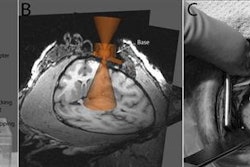Peripheral neuropathy, which damages the nervous system, occurs in as many as 75% of patients undergoing chemotherapy, according to the researchers. The condition could limit patients' treatment and hinder their quality of life.
The group evaluated the feet of nine cancer patients with and without chemotherapy-induced peripheral neuropathy by vibration perception threshold (VPT) testing, which is used to diagnose and measure peripheral neuropathy. A VPT score of more than 25 volts confirms the presence of the condition.
The researchers used MR neurography and diffusion-tensor imaging (DTI) to examine subjects' posterior tibial nerve and medial plantar and lateral plantar nerves. They assessed the extent of peripheral neuropathy through fractional anisotropy and apparent diffusion coefficient (ADC) values. They compared the results of the chemotherapy-induced peripheral neuropathy patients (eight feet) and those without peripheral neuropathy (seven feet).
ADC values for the posterior tibial nerve were significantly lower than ADC values for the medial plantar nerve in all feet, the researchers found. There was a correlation for fractional anisotropy and ADC values at specific nerve locations with chemotherapy-induced peripheral neuropathy. The fractional anisotropy and ADC values in the left lateral plantar nerve had the strongest positive correlations.
"This pilot study provides preliminary data showing correlations between fractional anisotropy and ADC measurements with chemotherapy-induced peripheral neuropathy," wrote Dr. Lana Hirai Gimber, director of musculoskeletal tumor imaging at the University of Arizona College of Medicine, and colleagues. "A larger, more definitive study of MR neurography with DTI as an objective biomarker and possible early predictor for chemotherapy-induced peripheral neuropathy is warranted."



















